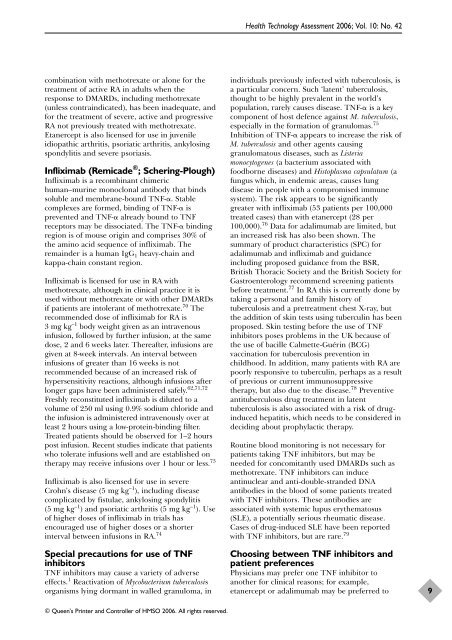A systematic review of the effectiveness of adalimumab
A systematic review of the effectiveness of adalimumab
A systematic review of the effectiveness of adalimumab
You also want an ePaper? Increase the reach of your titles
YUMPU automatically turns print PDFs into web optimized ePapers that Google loves.
combination with methotrexate or alone for <strong>the</strong><br />
treatment <strong>of</strong> active RA in adults when <strong>the</strong><br />
response to DMARDs, including methotrexate<br />
(unless contraindicated), has been inadequate, and<br />
for <strong>the</strong> treatment <strong>of</strong> severe, active and progressive<br />
RA not previously treated with methotrexate.<br />
Etanercept is also licensed for use in juvenile<br />
idiopathic arthritis, psoriatic arthritis, ankylosing<br />
spondylitis and severe psoriasis.<br />
Infliximab (Remicade ® ; Schering-Plough)<br />
Infliximab is a recombinant chimeric<br />
human–murine monoclonal antibody that binds<br />
soluble and membrane-bound TNF-. Stable<br />
complexes are formed, binding <strong>of</strong> TNF- is<br />
prevented and TNF- already bound to TNF<br />
receptors may be dissociated. The TNF- binding<br />
region is <strong>of</strong> mouse origin and comprises 30% <strong>of</strong><br />
<strong>the</strong> amino acid sequence <strong>of</strong> infliximab. The<br />
remainder is a human IgG 1 heavy-chain and<br />
kappa-chain constant region.<br />
Infliximab is licensed for use in RA with<br />
methotrexate, although in clinical practice it is<br />
used without methotrexate or with o<strong>the</strong>r DMARDs<br />
if patients are intolerant <strong>of</strong> methotrexate. 70 The<br />
recommended dose <strong>of</strong> infliximab for RA is<br />
3mgkg –1 body weight given as an intravenous<br />
infusion, followed by fur<strong>the</strong>r infusion, at <strong>the</strong> same<br />
dose, 2 and 6 weeks later. Thereafter, infusions are<br />
given at 8-week intervals. An interval between<br />
infusions <strong>of</strong> greater than 16 weeks is not<br />
recommended because <strong>of</strong> an increased risk <strong>of</strong><br />
hypersensitivity reactions, although infusions after<br />
longer gaps have been administered safely. 62,71,72<br />
Freshly reconstituted infliximab is diluted to a<br />
volume <strong>of</strong> 250 ml using 0.9% sodium chloride and<br />
<strong>the</strong> infusion is administered intravenously over at<br />
least 2 hours using a low-protein-binding filter.<br />
Treated patients should be observed for 1–2 hours<br />
post infusion. Recent studies indicate that patients<br />
who tolerate infusions well and are established on<br />
<strong>the</strong>rapy may receive infusions over 1 hour or less. 73<br />
Infliximab is also licensed for use in severe<br />
Crohn’s disease (5 mg kg –1 ), including disease<br />
complicated by fistulae, ankylosing spondylitis<br />
(5 mg kg –1 ) and psoriatic arthritis (5 mg kg –1 ). Use<br />
<strong>of</strong> higher doses <strong>of</strong> infliximab in trials has<br />
encouraged use <strong>of</strong> higher doses or a shorter<br />
interval between infusions in RA. 74<br />
Special precautions for use <strong>of</strong> TNF<br />
inhibitors<br />
TNF inhibitors may cause a variety <strong>of</strong> adverse<br />
effects. 1 Reactivation <strong>of</strong> Mycobacterium tuberculosis<br />
organisms lying dormant in walled granuloma, in<br />
© Queen’s Printer and Controller <strong>of</strong> HMSO 2006. All rights reserved.<br />
Health Technology Assessment 2006; Vol. 10: No. 42<br />
individuals previously infected with tuberculosis, is<br />
a particular concern. Such ‘latent’ tuberculosis,<br />
thought to be highly prevalent in <strong>the</strong> world’s<br />
population, rarely causes disease. TNF- is a key<br />
component <strong>of</strong> host defence against M. tuberculosis,<br />
especially in <strong>the</strong> formation <strong>of</strong> granulomas. 75<br />
Inhibition <strong>of</strong> TNF- appears to increase <strong>the</strong> risk <strong>of</strong><br />
M. tuberculosis and o<strong>the</strong>r agents causing<br />
granulomatous diseases, such as Listeria<br />
monocytogenes (a bacterium associated with<br />
foodborne diseases) and Histoplasma capsulatum (a<br />
fungus which, in endemic areas, causes lung<br />
disease in people with a compromised immune<br />
system). The risk appears to be significantly<br />
greater with infliximab (53 patients per 100,000<br />
treated cases) than with etanercept (28 per<br />
100,000). 76 Data for <strong>adalimumab</strong> are limited, but<br />
an increased risk has also been shown. The<br />
summary <strong>of</strong> product characteristics (SPC) for<br />
<strong>adalimumab</strong> and infliximab and guidance<br />
including proposed guidance from <strong>the</strong> BSR,<br />
British Thoracic Society and <strong>the</strong> British Society for<br />
Gastroenterology recommend screening patients<br />
before treatment. 77 In RA this is currently done by<br />
taking a personal and family history <strong>of</strong><br />
tuberculosis and a pretreatment chest X-ray, but<br />
<strong>the</strong> addition <strong>of</strong> skin tests using tuberculin has been<br />
proposed. Skin testing before <strong>the</strong> use <strong>of</strong> TNF<br />
inhibitors poses problems in <strong>the</strong> UK because <strong>of</strong><br />
<strong>the</strong> use <strong>of</strong> bacille Calmette-Guérin (BCG)<br />
vaccination for tuberculosis prevention in<br />
childhood. In addition, many patients with RA are<br />
poorly responsive to tuberculin, perhaps as a result<br />
<strong>of</strong> previous or current immunosuppressive<br />
<strong>the</strong>rapy, but also due to <strong>the</strong> disease. 78 Preventive<br />
antituberculous drug treatment in latent<br />
tuberculosis is also associated with a risk <strong>of</strong> druginduced<br />
hepatitis, which needs to be considered in<br />
deciding about prophylactic <strong>the</strong>rapy.<br />
Routine blood monitoring is not necessary for<br />
patients taking TNF inhibitors, but may be<br />
needed for concomitantly used DMARDs such as<br />
methotrexate. TNF inhibitors can induce<br />
antinuclear and anti-double-stranded DNA<br />
antibodies in <strong>the</strong> blood <strong>of</strong> some patients treated<br />
with TNF inhibitors. These antibodies are<br />
associated with systemic lupus ery<strong>the</strong>matosus<br />
(SLE), a potentially serious rheumatic disease.<br />
Cases <strong>of</strong> drug-induced SLE have been reported<br />
with TNF inhibitors, but are rare. 79<br />
Choosing between TNF inhibitors and<br />
patient preferences<br />
Physicians may prefer one TNF inhibitor to<br />
ano<strong>the</strong>r for clinical reasons; for example,<br />
etanercept or <strong>adalimumab</strong> may be preferred to<br />
9
















